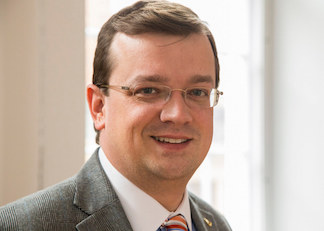Civil War Back to School: Shenandoah University’s McCormick Civil War Institute
 (Part three in a series)
(Part three in a series)
As we look at how the Civil War world has adjusted to “back to school,” we hear today from Jonathan A. Noyalas, the director of Shenandoah University’s McCormick Civil War Institute in Winchester, Virginia, and editor of the Journal of the Shenandoah Valley During the Civil War Era:
Very shortly after Shenandoah University—like every other single institution in the nation—went completely online for the duration of the spring semester, I was interviewed by the Chronicle of Higher Education about how both my students and I were adapting to this new learning environment. One of the points I made during that interview was that, like everything else in life, you run into obstacles, and however insurmountable they might seem you must find a way to overcome, reinvent, and adapt.
Shenandoah University has done just that. The University has adapted a form of the Hyflex teaching model, what Shenandoah calls “Shen-Flex.” This model allows us to adapt to any situation and do so quickly. Under this model, students can attend class in-person, so long as there is capacity in the classroom. Throughout the summer Shenandoah carefully studied the capacity of each classroom, allowing for proper physical distancing, etc. Using the Shen-Flex model, students have a choice, as does the faculty member, about how they participate in the course on any given day. Students can attend in-person or remote synchronous. If for some reason a student cannot participate in the course synchronously, students can participate in the course asynchronously.
Needless to say this required some significant retooling of the courses I am teaching this semester—Civil War & Reconstruction and two sections of The Uses, Abuses, and Purpose of History—but I believe all of the work I’ve put into redesigning courses to make all students feel a sense of connection to the course, wherever they are located, is paying off. Each fall semester I take students in my freshmen seminar (Uses, Abuses, and Purpose of History) to examine the complexities of Gettysburg’s commemorative landscape. While that won’t happen this semester as a result of the pandemic, I spent time this summer creating I-Movie modules about various places at Gettysburg we would have visited to still give them some sort of experience.
Although we’re only one week into the fall semester, I feel like things are going pretty smoothly. At this very early stage of the semester, about 90% of my students are attending class in-person, and while the classroom looks a bit different—with extra cameras and microphones for remote delivery; physical distancing; everyone (including me) wearing masks; and cleaning protocols in place (students assist me in wiping down the classroom at the end of class to get ready for the next class)—at the end of the day I am doing what I love, teaching and engaging my students in discussion.
Shenandoah University has done an AMAZING job of making certain that we have as safe an environment in which to teach and work as humanly possible. In addition to testing, each member of the University community completes a daily health-check in order to gain access to campus and classrooms. I truly believe that Shenandoah is doing everything possible to create a safe environment where quality instruction can happen. Students with whom I have spoken have expressed that to me, too. While some might charge me with being too much of an optimist at a time when it is perhaps easier to be pessimistic, I believe that the way Shenandoah has adapted to this crisis is first-rate. The University, of course, has always had a pandemic plan in place—all we are doing now is implementing that plan.